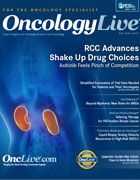Publication
Article
Oncology Live®
Caught up in Change
Author(s):
The relentless pace of change in cancer research and care is hardly news to practicing oncologists. It is worthwhile, however, to pause at times and ponder the implications of the speed and complexity of those developments.
OncLive Chairman,
Mike Hennessy
The relentless pace of change in cancer research and care is hardly news to practicing oncologists. It is worthwhile, however, to pause at times and ponder the implications of the speed and complexity of those developments.
The consequences of breakneck changes in the field emerge in this issue of OncologyLive® in several ways. In our cover story, “RCC Advances Shake Up Drug Choices,” we delve into the journey of axitinib (Inlyta) from a drug that once looked headed for a frontline indication in renal cell carcinoma to an agent that is being pushed into the background by newer therapies. Notably, that trajectory has taken place in approximately 5 years, not a very long time in the lifecycle of a drug.
The axitinib experience is an indication of how the anticancer armamentarium has expanded in metastatic RCC since the first targeted therapy, sorafenib (Nexavar), was approved for the tumor type in late 2005. Since then,9 new medicines have gained the FDA’s approval. In summary, these drugs are aimed at 3 distinct biological processes that had not been elucidated until this era of discovery.
This is certainly positive news for patients with RCC who are enjoying longer lifespans. Nevertheless, there are challenges for oncologists. They must keep abreast of research advances so they can determine how clinical trial findings might affect their patients—or these new therapies will not achieve their full potential.
When it comes to translating such data into meaningful information, the oncology community often falls short, notes Maurie Markman, MD, our physician editor-in-chief. In his column, “Simplified Summaries of Trial Data Needed for Patients and Their Oncologists,” Markman discusses the necessity for breaking down findings so that patients can understand the evidence that applies to their choices.
For example, why tell a patient that the objective response rate to a given therapy is 33% instead of simply saying approximately 1 in 3 people who received the drug experienced a benefit? That’s a straightforward example for a concept that advocates meeting the patient on a level where he or she can grasp the risk-versus- bene t calculation that underpins most treatment decisions.
We hope you find these articles interesting and thought provoking, particularly as we head into another season of major oncology conferences. We would love to hear your thoughts on these important issues. If you want to be part of this conversation, please contact our managing editor, Anita T. Shaffer, at ashaffer@onclive.com. And, as always, thank you for reading.



























%20(2)%201-Recovered-Recovered-Recovered-Recovered-Recovered-Recovered-Recovered-Recovered-Recovered-Recovered-Recovered-Recovered-Recovered-Recovered-Recovered-Recovered-Recovered.jpg?fit=crop&auto=format)
%20(2)%201-Recovered-Recovered-Recovered-Recovered-Recovered-Recovered-Recovered-Recovered-Recovered-Recovered-Recovered-Recovered-Recovered-Recovered-Recovered-Recovered-Recovered.jpg?fit=crop&auto=format)
